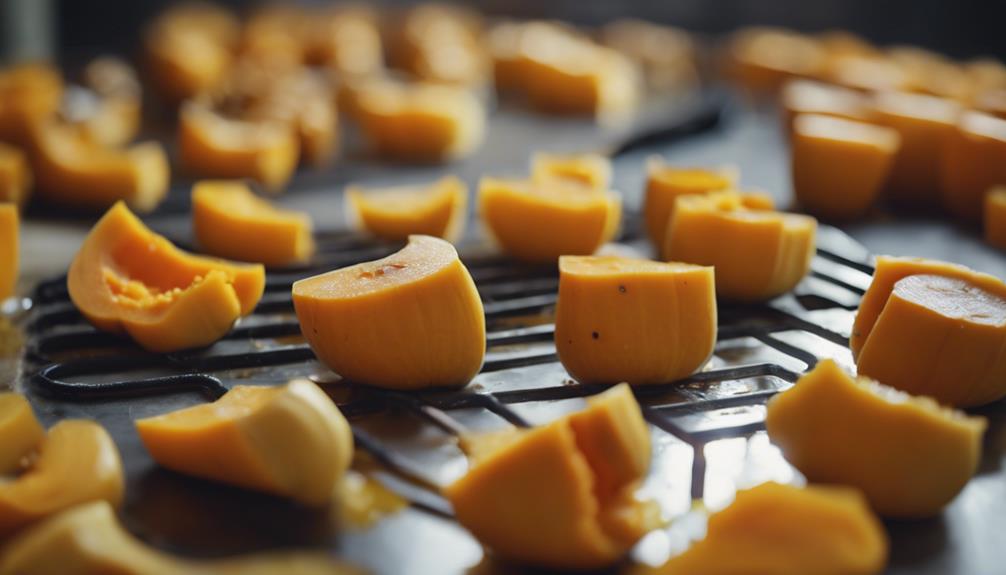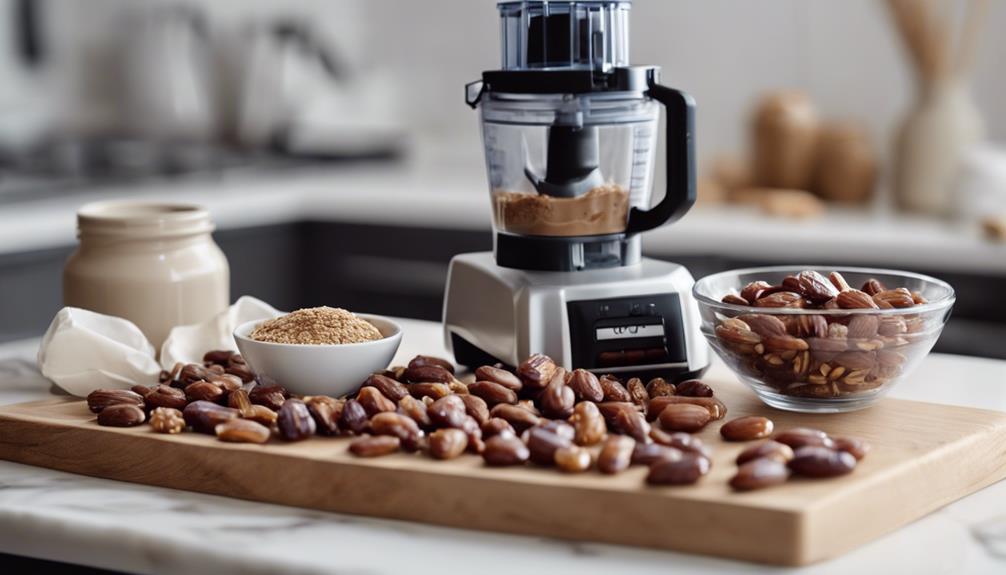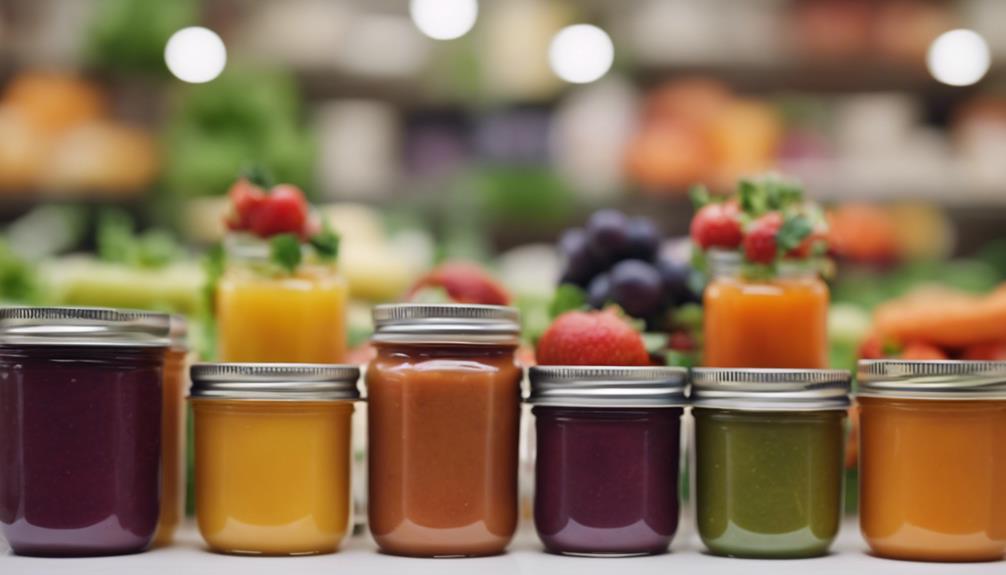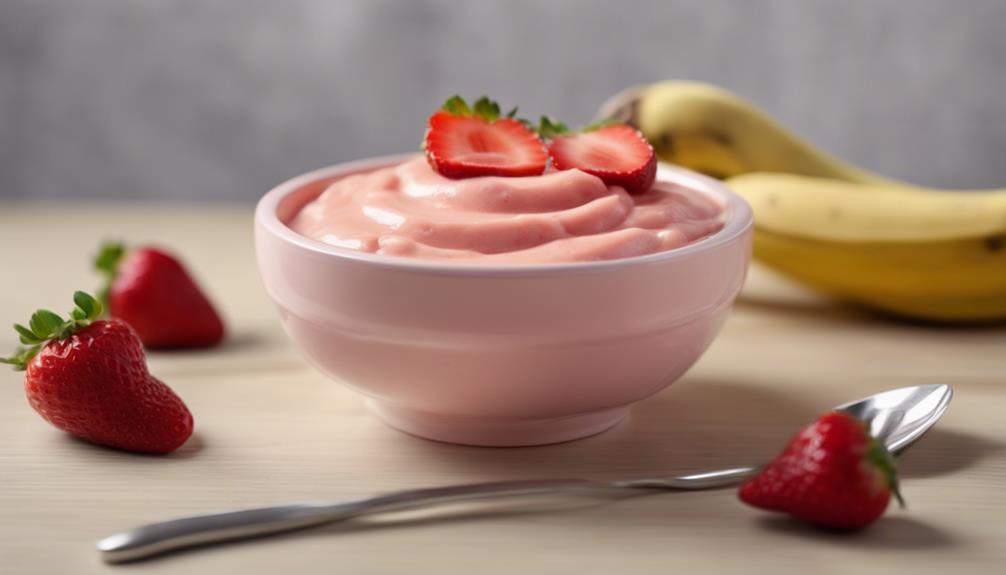For nutritious baby butternut squash recipes, try incorporating nutrient-packed options. One idea is to roast the squash to enhance its sweetness and flavor. You can also blend it with other ingredients to create a variety of tastes. This will help achieve a smooth consistency, making it easier for your baby to swallow and digest. These recipes are filled with essential vitamins A and C, crucial for vision, immunity, and growth. The fiber in these recipes promotes healthy digestion and prevents constipation, while the potassium helps maintain healthy blood pressure and muscle function. Cooking methods such as baking or boiling the squash ensure safe consumption. Be sure to avoid additives like salt, sugar, or honey for the health of your baby. Discover delicious butternut squash recipes suitable for different baby food stages.
Key Takeaways
- Roasted Butternut Squash Puree is a nutritious and flavorful option for baby's first foods.
- Butternut Squash Quinoa provides a wholesome blend of protein and vitamins for growing babies.
- Spiced Butternut Squash Puree introduces diverse flavors to expand your baby's palate.
- Incorporate butternut squash into various baby food stages for a well-rounded nutritional profile.
- Boil or bake butternut squash for baby food to retain essential nutrients and create tasty dishes.
When to Introduce Butternut Squash
When introducing butternut squash to your baby, around 6 months of age is an ideal time to start incorporating this nutritious food into their diet. Butternut squash is a great choice for your baby's first foods due to its rich content of vitamins and minerals essential for their growth and development. This vegetable is gentle on your baby's tummy, making it easy to digest and rarely causing allergies, which is important when introducing new foods to infants.
You can prepare butternut squash for your baby in various ways, such as purees or mashes. These forms make it convenient for your little one to consume and enjoy the flavors and textures of this nutritious vegetable.
Starting with butternut squash early can help your baby develop a taste for a diverse range of healthy foods, setting a strong foundation for their future eating habits. Overall, introducing butternut squash to your baby can be a nutritious and delicious addition to their diet.
Benefits of Butternut Squash

Butternut squash offers a myriad of benefits for your little one. Packed with essential vitamins and minerals, it supports healthy growth and development.
Its versatility in cooking allows you to incorporate this nutrient-rich fruit into various baby food recipes.
Nutrient-Rich Butternut Squash
Consider incorporating the nutrient-rich butternut squash into your baby's diet to provide essential vitamins and minerals important for their growth and development.
Butternut squash is a powerhouse of nutrients, such as vitamins A and C, vital for immune function and overall growth in infants.
This homemade baby food option, whether roasted or pureed, offers magnesium and potassium, supporting muscle and nerve function in your little one.
Additionally, the carotenoids present in butternut squash aid in converting vitamin A, promoting healthy vision and skin development.
Moreover, the soluble and insoluble fiber found in butternut squash plays a key role in maintaining healthy digestion and regulating bowel movements in babies.
Versatile Cooking Options
Enhance your baby's meals with the versatile cooking options of nutrient-rich butternut squash. Roasted butternut squash offers a delicious twist to traditional baby food. By roasting, you can intensify its natural sweetness and flavor, making it appealing to your little one's taste buds. This cooking method also helps retain essential nutrients like Vitamin A, Vitamin C, fiber, and potassium, ensuring that your baby gets a healthy dose of goodness in every bite.
Pureeing butternut squash opens up a world of culinary possibilities for creating diverse baby food recipes. You can blend it with other ingredients such as quinoa, sweet potatoes, or fruits to introduce varied flavors and textures to your baby's diet. The smooth consistency of butternut squash puree makes it easy for your baby to swallow and digest, making it an ideal choice for weaning.
Incorporating roasted butternut squash or puree into your baby's meals not only enhances the taste but also provides essential nutrients to support their growth and development.
Health Benefits Highlighted
Highlighting the health benefits of butternut squash, you'll discover a powerhouse of essential nutrients for your baby's growth and well-being. Butternut squash baby food isn't only delicious but also packed with vitamins A and C. Vitamin A supports healthy vision, immune function, and overall growth in infants, while Vitamin C aids in iron absorption and boosts the immune system.
Homemade baby food recipes incorporating butternut squash provide a healthy option for your little one, promoting their well-being through nutritious ingredients. Whether you're following baby-led weaning or looking for nutritious baby food options, butternut squash is a fantastic choice.
This vegetable's fiber content helps with digestion and prevents constipation in babies, ensuring their tummies stay happy. Additionally, the potassium in butternut squash contributes to maintaining healthy blood pressure and muscle function as your baby grows.
Including butternut squash in your baby's diet provides essential magnesium for bone development and carotenoids for antioxidant protection, making it a valuable addition to their meals.
Safety Concerns for Babies

Make sure butternut squash is thoroughly cooked until soft and mashable to prevent choking hazards for your baby. When introducing butternut squash to babies, safety concerns should be a top priority. Always consult with a pediatrician before incorporating it into your baby's diet. Below is a table summarizing key safety tips for feeding butternut squash to your little one:
| Safety Concerns for Babies | ||
|---|---|---|
| 1. Cook thoroughly | 2. Avoid additives | 3. Check for spoilage |
| Make certain butternut squash is cooked until soft and mashable. | Avoid adding salt, sugar, or honey to butternut squash recipes. | Check for signs of spoilage before feeding stored butternut squash purees. |
Selecting the Best Squash

When choosing butternut squash for your baby's meals, prioritize selecting solid, dull dark beige squash without green streaks for the best quality. Opt for squash that feels firm, heavy, and has an intact stem to guarantee freshness.
Avoid squash with serious cuts or soft spots as they may impact the quality of the squash. Select the heaviest squash of similar size as it often indicates better taste and texture.
Proper selection of butternut squash is essential for preparing delicious and nutritious baby food recipes. By paying attention to these details, you can make sure that the squash you choose is of the highest quality, providing your baby with the best flavors and nutrients.
Remember that selecting the right squash is the first step towards creating wholesome meals for your little one.
Cooking Methods for Babies

When it comes to cooking methods for babies, you have a few options to explore.
Steaming butternut squash can help preserve its nutrients and natural flavors, making it a healthy choice for your little one.
Baking the squash enhances its sweetness, while boiling provides a quick cooking method, though some nutrients may be lost in the water.
Steaming for Baby
When introducing your baby to the benefits of steaming butternut squash, start by gently cooking the squash with steam to preserve its nutrients and flavors.
Steaming butternut squash for babies is a quick and easy method that retains more nutrients compared to other cooking techniques. Here are some key points to keep in mind:
- Steaming butternut squash maintains its natural flavors and textures, making it appealing for baby food.
- This gentle cooking method helps preserve the vibrant color and taste of the squash, ensuring a sensory-rich experience for your baby.
- Steaming is a recommended technique for preparing butternut squash for babies due to its simplicity and health benefits.
- It's a convenient method that requires minimal equipment and preparation, perfect for busy parents.
- By steaming butternut squash, you can provide your baby with a nutritious and delicious food option that supports their growth and development.
Baking for Infants
Baking butternut squash for infants enhances its sweetness and caramelizes the flesh for a delicious taste. To start, preheat your oven to 400°F (200°C). Wash the squash thoroughly to remove any dirt.
Using a sharp knife, carefully cut the squash in half lengthwise and scoop out the seeds with a spoon. Place the halves on a baking sheet, cut side down. Roast in the oven for about 45-50 minutes until the flesh is tender.
Once baked, allow the squash to cool before handling. Scoop out the cooked flesh and store it in an airtight container in the fridge for up to three days.
For infants, puree the baked squash until smooth using a food processor or blender. This puree can be served as is or incorporated into various baby food recipes.
Baking is a safe and effective method to prepare nutrient-rich butternut squash for your little one's meals.
Boiling Baby Foods
Boiling is a common method used to prepare butternut squash for babies, guaranteeing a soft texture suitable for their consumption. When boiling butternut squash for baby foods, you're facilitating nutrient absorption and easy digestion.
Here are some key points to keep in mind when using this cooking method:
- Boiling helps soften the squash to a suitable texture for babies to consume.
- It's important to make sure that the squash is fully cooked and soft enough for easy mashing or pureeing.
- Boiling retains more nutrients compared to other cooking methods like frying.
- Boiling butternut squash for baby food allows for easy digestion and nutrient absorption.
Storage Tips for Baby Food

For maintaining freshness, store baby food in airtight containers in the refrigerator for up to 3 days.
To extend the storage time, consider freezing baby food in ice cube trays for convenient portioning and long-term storage of up to 3 months.
When freezing, make sure to transfer the frozen cubes into airtight containers to prevent freezer burn and maintain the quality of the food.
It's important to label containers with the date prepared to keep track of freshness and ensure timely consumption.
When ready to serve, thaw the frozen baby food in the refrigerator overnight for a gradual defrosting process.
Alternatively, you can use a microwave for quick defrosting, but always remember to stir well and check the temperature before feeding your little one.
Refrain from refreezing thawed baby food to preserve its taste and nutritional value.
Delicious Butternut Squash Recipes

Curious about how to create tasty butternut squash recipes for your little one? Butternut squash is a versatile ingredient that can be transformed into delicious and nutritious baby food recipes. Here are some ideas to get you started:
- Roasted Butternut Squash Puree: Roasting butternut squash brings out its natural sweetness and creates a smooth puree perfect for baby food.
- Plant-Based Protein Combo: Combine butternut squash with quinoa to provide a complete plant-based protein source for your growing baby.
- Flavorful Spices: Enhance the taste of butternut squash baby food recipes by adding spices like cinnamon, cumin, or ginger.
- Stage 2 and 3 Foods: Help your baby progress to more textured foods by incorporating butternut squash into Stage 2 and 3 meals.
- Diverse Palate Development: Introducing butternut squash at an early age helps in cultivating a diverse palate for your little one.
Try these recipes to not only nourish your baby but also to introduce them to a variety of flavors and textures essential for their healthy development.
Frequently Asked Questions
Is Butternut Squash Healthy for Babies?
Butternut squash is indeed healthy for babies! It's packed with Vitamin A, Vitamin C, and fiber, supporting immune function, eye health, and digestion. Its natural sweetness makes it appealing and a nutritious addition to baby meals.
How Do You Serve Baby Butternut Squash?
When serving baby butternut squash, you can puree, roast, steam, or blend it with other fruits and veggies for variety. Make sure to check for allergies and adjust the consistency based on your baby's age and needs.
Can You Eat Baby Butternut Squash?
Yes, you can eat baby butternut squash! These tender and sweet mini squashes are nutritious and versatile. Roast, steam, or puree them for flavorful dishes. Packed with Vitamin A, C, fiber, and potassium, they support healthy development.
Can I Give My 4 Month Old Squash?
Before giving your 4-month-old squash, remember their delicate digestive system isn't ready for solids. Stick to breast milk or formula as their main nourishment. Wait until around 6 months and consult your pediatrician first.
Conclusion
To sum up, introducing butternut squash into your baby's diet can be a nutritious and delicious choice. By following safety guidelines, selecting the best squash, and using proper cooking methods, you can create healthy and tasty meals for your little one.
Remember, just like the butternut squash, with time and care, your baby will grow and thrive, nourished by the wholesome goodness you provide. So go ahead, get cooking and enjoy watching your baby blossom!










